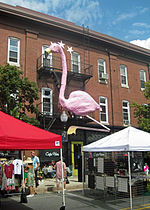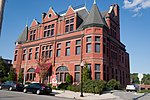Grace-Hampden Methodist Episcopal Church
19th-century Methodist church buildings in the United StatesBaltimore Registered Historic Place stubsChurches completed in 1899Churches in BaltimoreChurches on the National Register of Historic Places in Maryland ... and 3 more
Hampden, BaltimoreMaryland church stubsProperties of religious function on the National Register of Historic Places in Baltimore

Grace-Hampden Methodist Episcopal Church is a historic Methodist Episcopal church located at Baltimore, Maryland, United States. It is a large stone building constructed in 1899. The Romanesque Revival-style church features multiple gables and a square bell tower and masonry construction utilizing local granite with round-arched openings and decorative sill and lintel courses. It was the first ecclesiastical commission of local architect George Clifton Haskell.Grace-Hampden Methodist Episcopal Church was listed on the National Register of Historic Places in 2001.
Excerpt from the Wikipedia article Grace-Hampden Methodist Episcopal Church (License: CC BY-SA 3.0, Authors, Images).Grace-Hampden Methodist Episcopal Church
West 36th Street, Baltimore
Geographical coordinates (GPS) Address Nearby Places Show on map
Geographical coordinates (GPS)
| Latitude | Longitude |
|---|---|
| N 39.331238888889 ° | E -76.633619444444 ° |
Address
Grace Hampden Methodist Church
West 36th Street 1014
21211 Baltimore
Maryland, United States
Open on Google Maps








